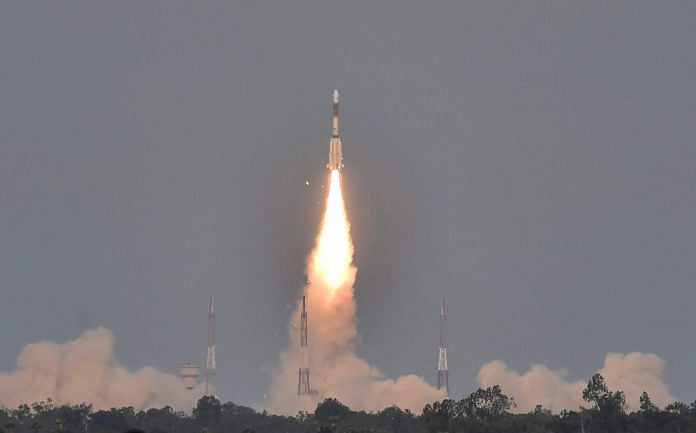The satellite’s engine was to be fired three times to place it in the correct orbit, but contact was reportedly lost after the second firing on 30 March.
Bengaluru: The Indian Space Research Organisation (ISRO) said Sunday that it has lost contact with the GSAT-6A satellite that was launched on 29 March.
In a statement on its website, it said that after two successful engine fires, the satellite stopped communicating with the ground. The link ceased just before the third engine firing, that was scheduled for Sunday.
The 6 m antenna aboard the GSAT-6A was one of the biggest India has launched. It was meant to significantly amplify two-way communication signal strength for the military in remote areas with small handheld devices instead of large receiving stations. The mission was expected to last 10 years.
Firing the engine to change orbit
After its release into orbit on 29 March, the 2,140 kg military communications satellite was inserted into a highly elliptical orbit of 169.4 km x 36,692 km. It was scheduled to make three orbit-raising manoeuvres over the next three days to reach its desired destination of a 36,000 km circular orbit.
The three manoeuvres planned were aimed at increasing its perigee (closest approach) from 169.4 km to 36,000 km, while lowering its apogee (farthest point of the orbit) from 36,692 km.
This is done by turning on its engines and giving the satellite a boost to go faster and change angle with each subsequent orbit. After ignition, the satellite reaches its desired velocity and the engine is turned off till it goes around the earth again and receives another boost. Thus, the elongated ellipse slowly bulges out into a circular path around the earth.
ISRO posted an update on its website on 30 March about the successful completion of the first burn and orbit raising manoeuvre at 9.22 am. After the first manoeuvre, the new orbit had become 5,054 km x 36,412 km. It had been silent since, with no updates in over 48 hours, prompting several news reports to wonder if something went wrong.
No official spokesperson has come forward, while senior members of the organisation remain unavailable, but several publications have quoted unnamed sources within. “Communication from the satellite was lost after the second firing of the on-board engine,” a source told The Hindu. The Times of India, on the other hand, quoted well-placed source as saying that the 53 minute-long second manoeuvre at 10.51am on 30 March went well, but communication was lost within four minutes after that. The third manoeuvre was scheduled for 11am on 1 April.
Power the common theme in ISRO failures
It’s as yet unclear what the reason for this failure is, though several sources point to problems in the power systems. Unofficial sources within ISRO told ThePrint that power failure caused the loss of telemetry — ISRO can no longer obtain data about its on-board instruments. That doesn’t mean the satellite can’t be tracked; optical tracking by North American Aerospace Defense Command (NORAD) will be done with ease. But it is unclear whether the satellite can be salvaged.
ISRO’s statement affirmed that “efforts are underway to establish the link with the satellite”.
The organisation has lost and regained communication with satellites in the past. The most famous of those is the Chandrayaan, which was launched in 2008 into orbit around the moon. Its DC to DC power converter failed, which caused overheating and failure of multiple components. Contact was lost in 2009, with repeated attempts to re-establish a link failing. Then, last year, NASA Jet Propulsion Laboratory’s ground-based radar detected it in the lunar orbit.
ISRO also had issues with three other satellites in orbit in the past: INSAT-2D, launched in June 1997, became inoperable in October the same year after a power bus anomaly; INSAT-4B, launched in 2007, experienced a partial power failure from one of its solar panels, leaving only 12 of its 24 transponders running and 70 per cent of connected households losing connectivity to Sun TV, Doordarshan and Tata VSNL; INSAT-4CR, also launched in 2007, went blank a month later after five orbit raising manoeuvres, and was found by NASA’s orbital debris tracker and brought back to orbit, using up so much fuel that its lifetime was reduced to half.
Afghansat-1, formerly known as Eutelsat W2M, which had been built upon ISRO’s satellite bus, had also experienced a partial power failure in 2010, causing ISRO to revise its design of the GSAT-8 before launch.
In the past, officials have expressed concerns that the repeated power failures had been caused because of imported components and solar cells used in the solar panel design. But the GSAT-6A’s components were all built in India.
ISRO’s impeccable launch record has also been blotted by partial and full test failures of the GSLV rocket. As the organisation moves more towards home-designed and built components, more expensive lessons are learned on the way.
It is possible that ISRO might have a contingency in place to establish lost contact, considering this was a military grade communications satellite.







No Sandhya INSAT-4CR didn’t lose 5 yrs of its life.. that is what hasty lifting off of public forums and not really knowing actual outcome would end you up with.